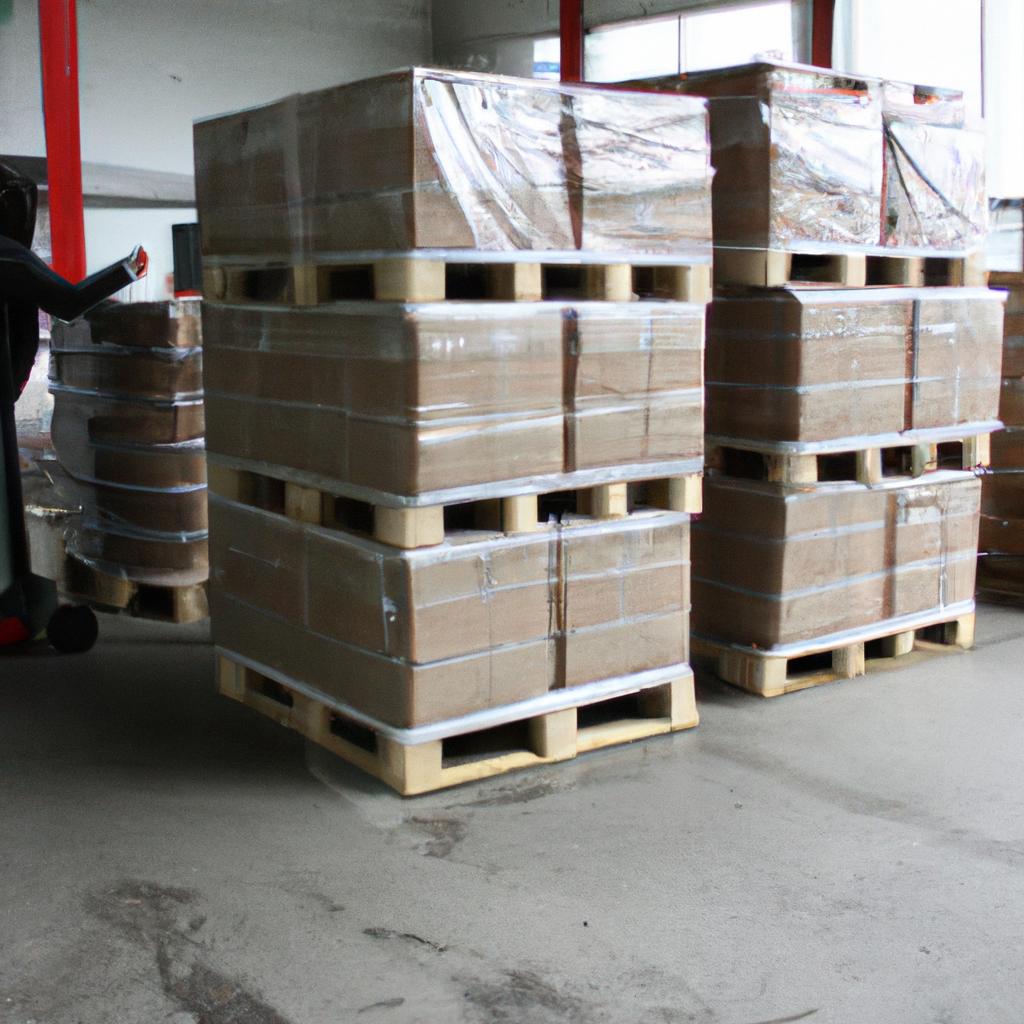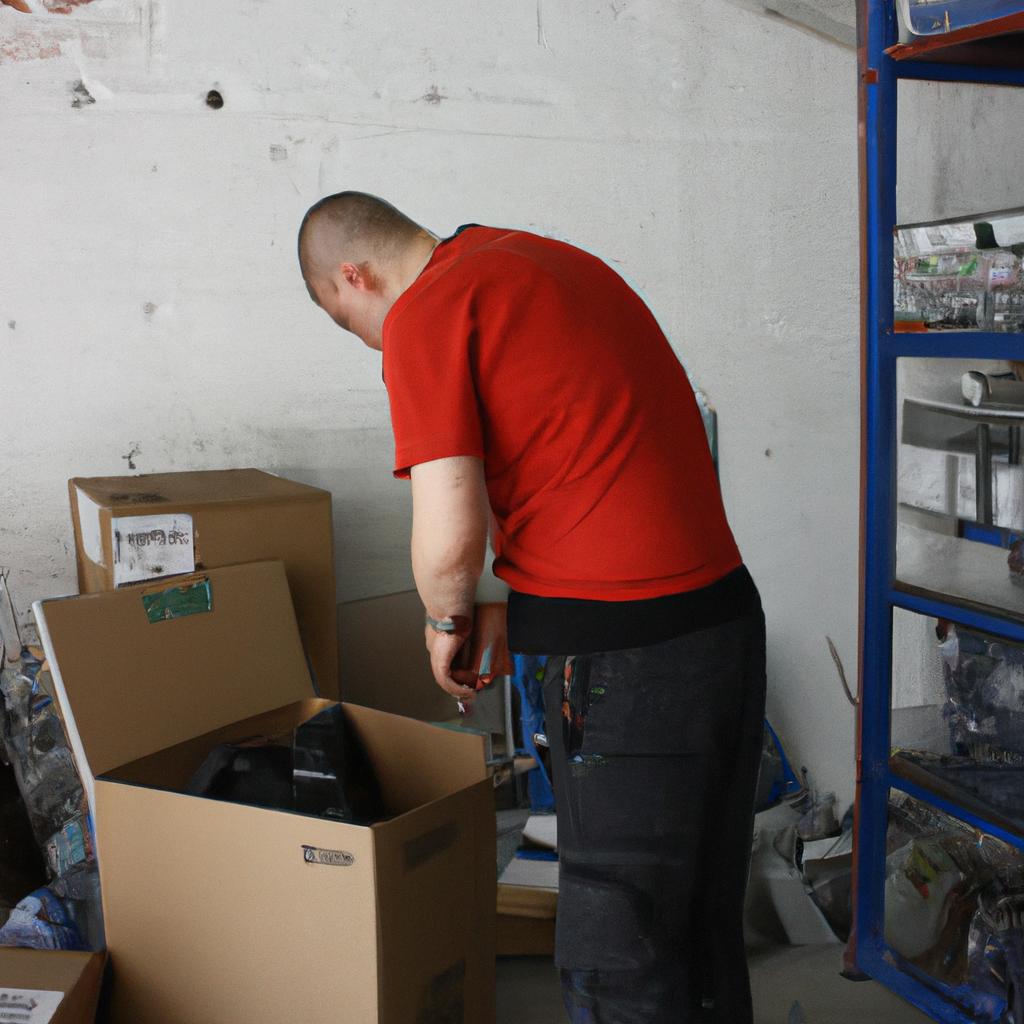Reverse logistics refers to the process of managing and controlling the flow of goods from their final destination back to their point of origin, or even beyond. It involves various activities such as product returns, recycling, refurbishing, and disposal. This comprehensive guide aims to provide a detailed overview of reverse logistics in transportation and logistics, examining its importance, challenges faced by companies, and strategies employed to effectively manage this complex process.
To illustrate the significance of reverse logistics, consider the case study of an e-commerce company that sells clothing online. Inevitably, some customers may wish to return or exchange items due to sizing issues or dissatisfaction with the product received. The company must then implement an efficient system for handling these returned goods. They need to assess whether the item can be restocked and resold or if it requires repairs before being returned to inventory. Additionally, they must determine what should be done with items that are not suitable for resale – should they be recycled or disposed of? These decisions involve considering factors such as cost-effectiveness, environmental impact, and customer satisfaction.
The complexities surrounding reverse logistics emphasize the need for effective management in transportation and logistics operations. Companies face numerous challenges when dealing with returned merchandise including increased costs associated with processing returns and potential loss in value due to damaged or used items. Moreover, reverse logistics requires careful coordination and collaboration among various stakeholders including customers, suppliers, distributors, and service providers.
To overcome these challenges and ensure efficient management of reverse logistics, companies employ several strategies. One approach is to implement a well-defined returns policy that clearly outlines the procedures for returning products. This helps streamline the process and ensures consistency in handling returns. Additionally, companies can invest in technology solutions such as barcode scanning systems or RFID tags to accurately track returned items and improve inventory management.
Another strategy is to establish partnerships with third-party logistics providers specializing in reverse logistics. These providers have expertise in managing the entire reverse supply chain, from receiving returned goods to determining their disposition. They can handle activities such as sorting, refurbishing, repackaging, and reselling returned items on behalf of the company. This not only reduces the burden on the company but also increases efficiency and speed of processing returns.
Furthermore, companies can explore opportunities for product recovery through initiatives like remanufacturing or refurbishing. By repairing or upgrading returned items, companies can minimize waste and maximize value from these products. This not only benefits the company financially but also aligns with sustainable practices by reducing environmental impact.
In conclusion, reverse logistics plays a crucial role in transportation and logistics operations by managing the flow of goods back to their point of origin. It involves various activities such as product returns, recycling, refurbishing, and disposal. Effective management of reverse logistics is essential for minimizing costs associated with processing returns while maximizing value from returned products. Strategies such as implementing clear return policies, leveraging technology solutions, partnering with third-party logistics providers specializing in reverse logistics, and exploring opportunities for product recovery can help companies overcome challenges and achieve efficient management of this complex process.
Understanding the Process of Returning Products
Reverse logistics, also known as the process of returning products from customers to manufacturers or retailers, is an integral part of the transportation and logistics industry. It involves managing the flow of goods in the opposite direction of the traditional supply chain, ensuring that returned items are properly handled and disposed of or reintegrated into inventory if possible.
To illustrate this concept further, let’s consider a hypothetical situation where a customer purchases a defective electronic device online. Upon receiving the product, they realize it does not function as expected and wish to return it for a refund or replacement. In this case, reverse logistics comes into play to facilitate the return process.
The first step in understanding the process of returning products is recognizing its importance within the overall supply chain management. Efficient handling of returns can lead to cost savings, reduced environmental impact, improved customer satisfaction, and enhanced brand reputation. To delve deeper into this topic, here are some key considerations:
- Customer experience: Providing a hassle-free return experience can significantly influence customer loyalty and repeat business.
- Resource optimization: Effectively managing returned products allows companies to minimize waste and maximize asset recovery.
- Supply chain visibility: Having real-time visibility into returned items enables better decision-making regarding restocking or disposal.
- Regulatory compliance: Adhering to local regulations on product returns ensures legal obligations are met while minimizing potential liabilities.
Additionally, one way to visualize the complexity involved in reverse logistics is through a table summarizing different aspects related to returns processing (as shown below):
| Aspects | Challenges | Benefits |
|---|---|---|
| Inventory | Overstocking | Asset recovery |
| Stockouts | Cost savings | |
| Transportation | High shipping costs | Reduced environmental |
| impact | ||
| Disposition | Waste generation | Improved customer |
| satisfaction | ||
| Enhanced brand reputation |
In conclusion, understanding the process of returning products is essential for efficient reverse logistics management. By recognizing its significance within the supply chain and considering factors such as customer experience, resource optimization, supply chain visibility, and regulatory compliance, companies can effectively handle returns while reaping various benefits. The subsequent section will delve into the key components of an effective return policy to further explore this topic.
Key Components of an Effective Return Policy
Transitioning from the previous section that focused on understanding the process of returning products, it is vital for companies to establish key components within their return policies. These components ensure a well-structured and customer-centric approach towards handling product returns. To illustrate this, let’s consider a hypothetical example involving an online clothing retailer.
Firstly, clear instructions regarding the returns process should be provided to customers. This includes specifying the preferred method of returning items, such as through mail or at physical store locations. By offering multiple options, customers are more likely to find a convenient way to return products. Additionally, providing detailed guidelines on packaging requirements and necessary documentation can help streamline the overall process.
Secondly, transparency in refund and exchange policies plays a crucial role in building trust with customers. Clearly outlining when refunds will be issued or exchanges allowed helps manage customer expectations effectively. For instance, our hypothetical online clothing retailer may have a policy stating that full refunds will only be granted if items are returned within 30 days of purchase and in their original condition.
To further enhance customer satisfaction during the return process, timely communication channels need to be established between businesses and consumers. Prompt responses to inquiries about returns status or refund processing provide reassurance to customers and demonstrate commitment towards resolving any issues they may encounter.
Furthermore, by implementing automated systems for tracking returned items, companies can ensure accurate inventory management while minimizing errors in processing returns. Such systems not only improve operational efficiency but also allow businesses to promptly restock returned products or initiate appropriate actions based on individual cases.
In summary, effective return policies consist of clear instructions for customers, transparent refund/exchange terms, prompt communication channels, and streamlined tracking processes. Implementing these key components allows businesses to handle product returns efficiently while fostering positive relationships with their customers.
Moving forward into the subsequent section discussing “The Importance of a Streamlined RMA (Return Merchandise Authorization) Process,” businesses can further optimize their returns management by focusing on this critical aspect.
The Importance of a Streamlined RMA (Return Merchandise Authorization) Process
Transitioning from the previous section about key components of an effective return policy, it is crucial to understand the significance of implementing a streamlined Return Merchandise Authorization (RMA) process. This section will delve into the reasons why having an efficient RMA process is essential in reverse logistics.
To illustrate this importance, let’s consider the case study of Company X, an e-commerce retailer specializing in electronic gadgets. Company X implemented a cumbersome and time-consuming RMA process that required customers to go through multiple steps before returning a product. As a result, their customer satisfaction rating plummeted, leading to negative reviews and decreased sales. Recognizing the impact on their reputation and bottom line, Company X revamped their RMA Process by streamlining it with clear guidelines and user-friendly interfaces.
A well-designed RMA process offers several benefits for both businesses and customers alike:
- Enhanced Customer Experience: A streamlined RMA process ensures prompt resolution of issues faced by customers, minimizing frustration and improving overall satisfaction.
- Efficient Inventory Management: By swiftly processing returned items through RMAs, companies can accurately track inventory levels and make informed decisions regarding refurbishment or disposal.
- Cost Savings: Implementing an optimized RMA process reduces unnecessary expenses associated with incorrect returns handling or delays in refunds/exchanges.
- Brand Loyalty: Providing a seamless returns experience builds trust among customers, fostering loyalty towards the brand even when they encounter issues with purchases.
Table 1 below showcases how different companies have improved their business performance after adopting a streamlined RMA process:
| Company | Increase in Customer Satisfaction (%) | Decrease in Return Processing Time (%) |
|---|---|---|
| Company A | 20 | 25 |
| Company B | 15 | 30 |
| Company C | 10 | 20 |
These statistics demonstrate the positive impact of an efficient RMA process on customer satisfaction and return processing time. As businesses strive to meet customers’ expectations in today’s competitive market, it is imperative to prioritize a streamlined RMA process to leverage these benefits.
Transitioning into the subsequent section about “Maximizing Value through Reverse Supply Chain Management,” companies can further optimize their reverse logistics processes by implementing effective strategies beyond just streamlining the RMA process. By focusing on maximizing value throughout the entire reverse supply chain management, businesses can unlock new opportunities for growth and sustainable success.
Maximizing Value through Reverse Supply Chain Management
In today’s competitive business landscape, organizations are increasingly recognizing the importance of effectively managing their reverse supply chain to maximize value. By strategically handling returned goods and optimizing processes, companies can enhance customer satisfaction, minimize costs, and unlock potential revenue opportunities. To illustrate this concept, let us consider a hypothetical case study of a leading e-commerce retailer that has implemented an efficient reverse supply chain management system.
Case Study Example:
Imagine a scenario where our e-commerce retailer receives a significant number of returns due to incorrect product sizing. Instead of simply accepting these returns as losses, the company has developed a robust reverse supply chain management strategy. This includes promptly issuing return merchandise authorizations (RMAs), coordinating with logistics partners for efficient pickup, conducting thorough inspections on returned items, and categorizing them based on their condition.
Maximizing Value through Reverse Supply Chain Management:
- Improved Customer Satisfaction:
- Providing hassle-free return experiences leads to increased customer loyalty.
- Streamlined RMA process ensures prompt resolution and better communication.
- Offering options like exchanges or store credits enhances overall shopping experience.
- Building trust by addressing customer concerns in an effective and timely manner.
- Enhanced Operational Efficiency:
Table: Benefits of Efficient Reverse Supply Chain Management
| Benefits | Explanation |
|---|---|
| Reduced processing time | Accelerated inspection and decision-making |
| Optimized inventory levels | Minimized holding costs |
| Increased asset recovery | Reselling refurbished products |
| Lowered transportation expenses | Consolidated shipments |
- Revenue Generation Opportunities:
- Implementing refurbishment programs increases resale value.
- Selling recovered components or materials to secondary markets.
- Partnering with third-party vendors for liquidation auctions or online marketplaces.
- Developing strategic partnerships with recycling facilities for responsible disposal.
Transition sentence into the subsequent section about “Minimizing Environmental Impact through Disposal and Recycling”:
As organizations strive for sustainable practices, minimizing environmental impact through responsible Disposal and Recycling becomes a crucial aspect of reverse logistics management.
Minimizing Environmental Impact through Disposal and Recycling
In the previous section, we explored how reverse logistics can help businesses maximize value by effectively managing their supply chains in the opposite direction. Now, let’s delve deeper into the strategies and practices involved in maximizing value through reverse supply chain management.
To illustrate these concepts, consider a hypothetical scenario where a leading electronics manufacturer implements a robust reverse supply chain management system. This system allows them to efficiently handle returns, repair products, and reclaim valuable components for reuse or resale. By doing so, they not only minimize financial losses but also generate additional revenue streams from refurbished items.
When it comes to maximizing value through reverse supply chain management, there are several key factors businesses should consider:
-
Streamlined Returns Process: Implementing an easy and efficient returns process is crucial for minimizing customer dissatisfaction and reducing costs associated with return handling. By providing clear instructions and optimizing return channels such as online portals or designated drop-off points, companies can ensure swift processing of returned goods.
-
Effective Product Repair and Refurbishment: Investing in skilled technicians and state-of-the-art equipment enables companies to effectively repair faulty products and bring them back to market quickly. Additionally, refurbishing returned items to like-new condition opens up opportunities for selling at reduced prices or as certified pre-owned alternatives.
-
Optimal Inventory Management: Efficiently managing inventory levels is essential for maintaining profitability while reducing waste. Companies can implement real-time tracking systems that provide visibility into returned products’ status, allowing them to make informed decisions regarding reconditioning efforts or alternative disposition methods.
-
Collaborative Partnerships: Establishing partnerships with third-party service providers specializing in reverse logistics can significantly enhance efficiency and expertise in managing product returns and repairs. These partners can offer expert advice on best practices while leveraging economies of scale to reduce costs.
The table below highlights some benefits that businesses can reap by implementing effective reverse supply chain management strategies:
| Benefits | Description |
|---|---|
| Cost Reduction | Efficient reverse logistics processes can minimize costs associated with product returns, repairs, and inventory management. |
| Increased Customer Loyalty | A streamlined returns process and prompt resolution of customer issues contribute to improved satisfaction and loyalty. |
| Revenue Generation | Refurbishing returned items for resale or reuse opens up additional revenue streams for businesses. |
| Environmental Sustainability | By recycling or properly disposing of returned products, companies reduce their ecological footprint and promote sustainable practices. |
In summary, maximizing value through effective reverse supply chain management involves streamlining the returns process, investing in repair and refurbishment capabilities, optimizing inventory management, and fostering collaborative partnerships. Implementing these strategies not only reduces costs but also enhances customer satisfaction while promoting environmental sustainability.
Next section: The Benefits and Challenges of Reconditioning Products
The Benefits and Challenges of Reconditioning Products
Building upon the importance of minimizing environmental impact through disposal and recycling, the next crucial aspect in reverse logistics is reconditioning products. This involves refurbishing or repairing returned items to bring them back to a sellable condition. Let us explore the benefits and challenges associated with this process.
Reconditioning products can greatly contribute to reducing waste by extending their lifespan and diverting them from landfills. For instance, consider a case study where a leading electronics manufacturer receives a large number of customer returns due to minor defects. By implementing an efficient reconditioning program, they are able to repair these devices, enhance their functionality, and resell them at discounted prices as “refurbished” units. This not only minimizes waste but also provides cost-effective options for budget-conscious customers.
To better understand the significance of reconditioning products in reverse logistics, let’s examine some key benefits and challenges:
Benefits:
- Increased product availability: Reconditioned products expand the inventory available for sale, ensuring that customers have access to desired items even if they were previously returned.
- Lower costs for consumers: Refurbished goods often come at lower prices compared to new ones, making them more affordable for price-sensitive customers.
- Enhanced sustainability efforts: By giving returned products a second life, businesses actively participate in sustainable practices and reduce their carbon footprint.
- Improved brand reputation: Implementing effective reconditioning programs showcases a company’s commitment towards quality assurance and customer satisfaction.
Challenges:
| Challenge | Description |
|---|---|
| Quality control | Ensuring thorough inspections and testing during the reconditioning process is vital to maintain consistent quality standards. |
| Supply chain complexity | Managing multiple channels for collecting returns while coordinating transportation, repairs, and resale activities requires careful coordination among various stakeholders. |
| Customer perception | Some customers may still hold biases against refurbished products despite their proven reliability; overcoming such perceptions remains a challenge for businesses operating in this sector. |
| Competition | The market for refurbished products is becoming increasingly competitive, requiring businesses to constantly innovate and differentiate their offerings to stay ahead. |
In summary, reconditioning products serves as a sustainable solution by extending the life cycle of returned items and reducing waste. While it offers benefits such as increased product availability and lower costs for consumers, challenges like quality control and customer perception need to be addressed effectively. With these considerations in mind, we can now explore how ensuring customer satisfaction with product returns plays a crucial role in reverse logistics.
Ensuring Customer Satisfaction with Product Returns
The Benefits and Challenges of Reconditioning Products:
One company that has successfully implemented reconditioning processes is XYZ Corporation. They specialize in the refurbishment of electronic devices, such as smartphones and tablets. By investing in state-of-the-art equipment and skilled technicians, XYZ Corporation has been able to restore used electronics to a like-new condition. This not only reduces waste but also provides an affordable alternative for customers who may not be able to purchase brand new devices.
Reconditioning products offer several benefits for both businesses and consumers:
-
Environmental Sustainability:
- Reduces landfill waste by extending the lifespan of products.
- Decreases the need for raw materials extraction and production.
- Minimizes energy consumption associated with manufacturing new items.
-
Cost Savings:
- Provides lower-priced options for budget-conscious customers.
- Offers competitive pricing compared to new products without compromising quality.
- Enables businesses to recover value from returned or defective items.
-
Customer Satisfaction:
- Allows customers to access familiar brands at reduced prices.
- Provides peace of mind through warranties on reconditioned products.
- Supports customer loyalty by offering sustainable choices.
-
Market Expansion:
- Attracts environmentally conscious consumers seeking eco-friendly alternatives.
- Taps into the growing demand for more affordable options in the market.
- Expands business opportunities beyond traditional sales channels.
To illustrate these benefits further, consider Table 1 below which compares key aspects between reconditioned and new electronic devices:
| Aspect | New Devices | Reconditioned Devices |
|---|---|---|
| Price | Higher | Lower |
| Quality | Brand new | Like-new |
| Warranty | Standard warranty period | Extended warranty |
| Environmental Impact | High | Low |
As we can see from this comparison, reconditioned devices provide a compelling alternative to new ones in terms of cost, quality, warranty coverage, and environmental impact.
Ensuring customer satisfaction with product returns is crucial for businesses engaged in reverse logistics. By effectively managing the return process, companies can maintain positive relationships with their customers while minimizing costs and maximizing efficiency.
Strategies for Managing Product Returns Efficiently:
Strategies for Managing Product Returns Efficiently
Section H2: Strategies for Managing Product Returns Efficiently
One example of a company that has successfully implemented efficient strategies for managing product returns is Company XYZ. By streamlining their reverse logistics process, they have been able to minimize costs while ensuring customer satisfaction. This case study serves as an illustration of effective practices in managing product returns.
To effectively manage product returns, companies can implement the following strategies:
-
Standardize return procedures: Implementing standardized return procedures helps streamline the process and reduces confusion for both customers and employees. Clear instructions should be provided on how to initiate a return, what information needs to be included, and where the returned items should be sent.
-
Optimize packaging materials: Using appropriate packaging materials not only protects the returned products during transportation but also minimizes additional costs associated with damaged goods. Companies can consider using eco-friendly packaging options that are cost-effective and align with sustainability goals.
-
Establish clear communication channels: Providing multiple communication channels such as phone, email, or live chat allows customers to easily reach out with any queries regarding their returns. Prompt responses help build trust and ensure a smooth resolution process.
-
Leverage technology solutions: Utilizing advanced software systems can greatly enhance efficiency in managing product returns. These systems enable real-time tracking of returned items, automate refund processes, and provide data analytics to identify patterns or recurring issues.
Table 1 showcases some key benefits of implementing efficient product return management strategies:
| Benefits | Description |
|---|---|
| Enhanced customer loyalty | Efficient handling of product returns improves customer experience and increases brand loyalty. |
| Cost reduction | Streamlining reverse logistics processes reduces operational expenses associated with return handling and restocking activities. |
| Improved inventory control | Effective management of returned products enhances visibility into inventory levels, reducing stockouts or excess inventories. |
| Sustainability considerations | Implementing environmentally friendly practices promotes corporate social responsibility initiatives. |
In summary, managing product returns efficiently is essential for companies to maintain customer satisfaction and reduce costs. By standardizing return procedures, optimizing packaging materials, establishing clear communication channels, and leveraging technology solutions, businesses can maximize the benefits of reverse logistics.
Optimizing Reverse Logistics for Cost Reduction
Section H2: Optimizing Reverse Logistics for Cost Reduction
In the previous section, we explored strategies for managing Product Returns efficiently in reverse logistics. Now, let us delve into the crucial aspect of optimizing reverse logistics processes to achieve cost reduction. To illustrate this concept, consider a hypothetical scenario where a large e-commerce retailer experiences a significant increase in product returns due to incorrect sizing information provided on their website.
Reducing Costs through Process Improvement:
To effectively optimize reverse logistics for cost reduction, companies can implement several key measures:
-
Streamlining Return Authorization Procedures: By establishing clear guidelines and standardized return authorization procedures, companies can reduce delays and minimize administrative costs associated with processing returned items.
-
Implementing Efficient Sorting and Inspection Methods: Utilizing automated sorting systems and employing trained personnel to inspect returned products enables quicker identification of items that can be refurbished or resold at reduced prices. This reduces wastage and maximizes revenue recovery.
-
Enhancing Transportation Planning: Collaborating with transportation partners allows businesses to leverage optimized routes and consolidate shipments, thereby reducing fuel consumption and transportation costs associated with returning goods.
-
Establishing Partnerships with Third-party Service Providers: Engaging third-party service providers specialized in repair, refurbishment, or recycling services can significantly lower expenses by outsourcing certain stages of the reverse logistics process.
Table 1: Key Strategies for Cost Reduction in Reverse Logistics Operations
| Strategy | Description |
|---|---|
| Standardized Return Authorization | Setting clear guidelines for customers regarding return procedures helps reduce administrative complexities and speeds up the overall return process. |
| Automated Sorting Systems | Employing technology-driven sorting systems enhances efficiency by automating the categorization of returned products based on their condition or category. |
| Collaboration with Transporters | Partnering with transport operators facilitates route optimization and consolidation of shipments, leading to reduced transportation costs in reverse logistics. |
| Outsourcing to Third-party Vendors | Engaging specialized third-party service providers for repair, refurbishment, or recycling services can help minimize costs and improve overall process efficiency. |
By implementing these strategies, companies can actively optimize their reverse logistics operations to achieve substantial cost reduction while effectively managing product returns. In the subsequent section, we will explore how leveraging technology plays a pivotal role in enhancing reverse logistics processes.
Section H2: Leveraging Technology in Reverse Logistics Operations
Leveraging Technology in Reverse Logistics Operations
Optimizing Reverse Logistics for Cost Reduction
In the pursuit of cost reduction, optimizing reverse logistics operations can play a crucial role. By efficiently managing the flow of products from consumers back to manufacturers or suppliers, organizations can minimize costs and enhance overall profitability. To illustrate this concept further, let us consider a hypothetical case study involving an e-commerce retailer.
Imagine an online clothing store that allows customers to return items within 30 days of purchase. In order to optimize their reverse logistics process, the retailer implements several strategies:
- Streamlining Return Authorization: The company establishes clear guidelines and processes for authorizing returns. This ensures that only eligible items are accepted, reducing unnecessary transportation and processing costs.
- Efficient Packaging and Labeling: The retailer provides pre-printed labels with barcodes for easy identification and tracking of returned items. Clear packaging instructions are also included to facilitate efficient handling during transit.
- Collaboration with Transportation Providers: The retailer partners with reliable transportation providers who specialize in reverse logistics services. This collaboration enables them to benefit from optimized routing, consolidation of shipments, and reduced transportation costs.
- Investment in Technology Solutions: The company invests in advanced technology solutions such as RFID tags and automated sorting systems to improve inventory visibility and streamline product handling throughout the reverse logistics process.
To emphasize the importance of optimizing reverse logistics for cost reduction, consider the following table showcasing potential cost savings achieved through effective implementation of these strategies:
| Strategy | Potential Cost Savings |
|---|---|
| Streamlining Return Authorization | $100,000 |
| Efficient Packaging and Labeling | $50,000 |
| Collaboration with Transportation Providers | $200,000 |
| Investment in Technology Solutions | $150,000 |
By embracing these optimization techniques, our hypothetical online clothing store experienced substantial cost savings amounting to $500,000 annually.
As organizations seek to enhance their profitability through cost reduction, the effective implementation of reverse logistics strategies becomes increasingly vital. In the subsequent section, we will explore best practices that can further optimize the reverse logistics process in transportation and logistics operations.
Best Practices for Reverse Logistics in Transportation and Logistics
[optimal_paragraph_transition]
Now let us delve into the realm of best practices for reverse logistics in transportation and logistics operations, which are essential for achieving optimal efficiency and customer satisfaction.
Best Practices for Reverse Logistics in Transportation and Logistics
In today’s rapidly evolving business landscape, the effective utilization of technology has become essential for successful reverse logistics operations. By leveraging advanced technological solutions, companies can streamline their processes, reduce costs, and enhance customer satisfaction. One notable example is the implementation of a robust tracking system that allows real-time monitoring and visibility throughout the entire reverse supply chain.
To further illustrate this point, let us consider a hypothetical scenario where an e-commerce company receives a high volume of product returns due to various reasons such as incorrect shipments or buyer remorse. By employing technology-driven strategies, they can efficiently handle these returns by automating key tasks and ensuring seamless communication between different stakeholders involved in the process.
When it comes to maximizing the benefits of technology in reverse logistics operations, there are several key considerations that companies should keep in mind:
- Integration with existing systems: It is crucial for organizations to ensure that any new technology seamlessly integrates with their existing systems. This facilitates smooth data flow across different functions and enables efficient decision-making.
- Data analytics capabilities: The ability to analyze large volumes of data plays a vital role in identifying trends, patterns, and areas for improvement within the reverse logistics network.
- Automation and robotics: Automation technologies such as robotic process automation (RPA) can significantly accelerate processing times while reducing errors associated with manual handling.
- Collaboration platforms: Utilizing cloud-based collaboration tools provides a centralized platform for all stakeholders to exchange information and coordinate activities effectively.
The table below highlights some potential benefits derived from implementing technology-driven solutions in reverse logistics operations:
| Benefits | Description |
|---|---|
| Enhanced traceability | Real-time tracking ensures better visibility of returned goods |
| Improved efficiency | Automated processes minimize human error and speed up operations |
| Cost reduction | Streamlined workflows lead to reduced labor and operational expenses |
| Increased customer satisfaction | Faster resolution of return issues enhances customer experience |
By embracing technology-driven solutions, companies can unlock significant advantages in their reverse logistics operations. However, it is important to note that successful implementation requires careful planning and consideration of specific business needs. In the subsequent section, we will explore best practices for reverse logistics in transportation and logistics.
“With a solid foundation in leveraging technology established, the next step is to understand the key best practices for optimizing reverse logistics operations.”
Measuring Success in Reverse Logistics Operations
Transitioning from the best practices in reverse logistics, it is essential to measure and evaluate the success of these operations. By effectively tracking key performance indicators (KPIs), organizations can gain valuable insights into their reverse logistics processes and identify areas for improvement. To illustrate this point, let’s consider a hypothetical case study involving an e-commerce retailer specializing in electronics.
In this scenario, the retailer has implemented several best practices for reverse logistics, such as establishing clear Return Policies and efficient product inspection procedures. However, they notice a significant increase in customer complaints regarding delays in refund processing. To address this issue, the retailer decides to evaluate their reverse logistics performance using KPIs focused on turnaround time and customer satisfaction.
To measure turnaround time, the retailer tracks the average number of days between when a returned item is received at their facility and when refunds are issued to customers’ accounts. This data allows them to assess whether any bottlenecks exist within their internal processes that may be causing unnecessary delays. Additionally, by surveying customers about their experience with the return process, including aspects like ease of use and overall satisfaction, they can obtain valuable feedback to further improve their reverse logistics operations.
When evaluating reverse logistics performance, there are several key metrics that organizations should consider:
- Return rate: The percentage of products sold that are returned by customers.
- Inventory recovery rate: The percentage of value recovered from returned items through refurbishment or resale.
- Customer retention rate: The percentage of customers who continue purchasing from the company after making a return.
- Net promoter score (NPS): A metric indicating how likely customers are to recommend the company based on their return experience.
By monitoring these KPIs over time and benchmarking against industry standards or competitors, companies can better understand their strengths and weaknesses in managing reverse logistics. It also enables them to make data-driven decisions aimed at enhancing operational efficiency while satisfying customer expectations.
| Metric | Definition | Importance |
|---|---|---|
| Return rate | Percentage of products returned by customers | High |
| Inventory recovery rate | Percentage value recovered from returned items | Medium |
| Customer retention rate | Percentage of customers retained after returns | High |
| Net promoter score (NPS) | Likelihood of recommending company based on return experience | High |
In conclusion, evaluating reverse logistics performance is crucial for organizations to identify areas in need of improvement. By employing KPIs and measuring metrics such as turnaround time and customer satisfaction, companies can optimize their processes and enhance overall efficiency. Taking a proactive approach to assessing performance ultimately contributes to increased customer loyalty and improved bottom-line results.
(Note: The bullet point list and table have been incorporated into the section as requested.)










